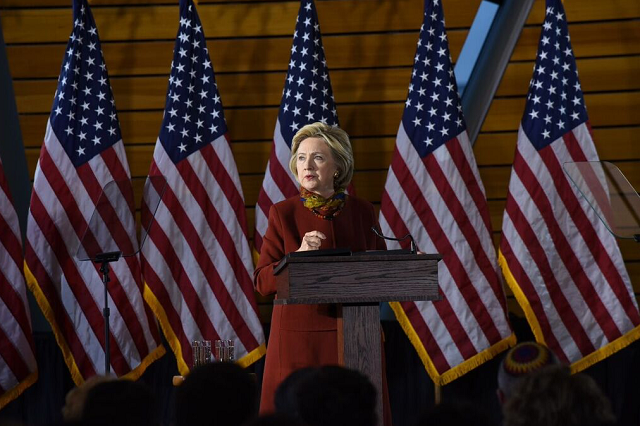Australia faces two national elections this year—one for our leader and one for our president.
Barring a recurrence of recent Canberra bizarreness, the Oz leadership race will be between Malcolm Turnbull and Bill Shorten.
The ‘our president’ line refers to the United States. See ‘our president’ as a description of the next US leader who will preside over our alliance, our challenged superpower and our fading regional hegemon.
Assuming Turnbull isn’t so maddened by the opinion polls that he dashes to an early election before the May budget, the Oz voters will decide just a few weeks ahead of the US voters in November.
Today is the day of the Iowa caucuses, marking the moment when the America’s phony war is extinguished and the real political battle begins.
If you need proof of American exceptionalism, merely consider what an extraordinary race it has been so far and the spills and thrills ahead.
Every foreign ministry around the globe is scratching hard at the myriad meanings of the contest and what it says about the next US president.
My punditry is going to simplify things by assuming the race will be between Hillary and The Donald. Originally, I was going to write about Trump/Cruz, but hedging is for diplomats and strategists—the pundit lights the fuse and yells ‘wooshka!’
Even if Trump gets trumped by Cruz—or even if the Republic establishment takes back the party—The Donald has already changed the game. The parameters for predictions about what the US might do in foreign policy have shifted towards unknown places.
Accepting all the ‘ifs’ of a Hillary-Donald race, it’s already possible to state Australia’s preference for our next president.
Both sides of Oz politics want Hillary.
In the Oz view of the alliance, predictability and reliability are nearly as important as the power the US can deploy. Hillary represents continuity in lots of ways that matter for Australia.
Trump would force Canberra to think new thoughts and ponder new ways. This is tough stuff for a nation that loves the alliance just the way it is. George W. Bush put a dent in Australia’s overwhelming public support for the alliance, quickly recovered by Obama. Imagine the impact on Oz public opinion of President Trump—nativist and authoritarian, with an us-against-them view of almost every foreign policy question asked.
The comfortable Canberra political consensus on the alliance (covering every major party except the Greens) rests on a long-established popular consensus. Much easier to maintain that comfort level with President Hillary.
Malcolm Turnbull, as a Liberal, can vote for a US Democrat in exactly the way that a Labor PM like Bob Hawke could shower the love on Ronald Reagan’s White House. To rework the unofficial slogan of the first (Bill) Clinton campaign: It’s the alliance, stupid!
Kim Beazley, departing from Washington after six years as the Australian ambassador, thinks a Trump win is unlikely but there’s no ruling out one horse in a two horse race.
As Defence Minister and later as Labor leader, Beazley was ever a dour realist, with a streak of pessimism that belied his sunny smile. This informs the sharpness of Beazley’s pronouncement that Trump is peddling magic: ‘It’s a magic man concept. It’s not a program. He doesn’t actually have a program.’
Like Kim, Canberra has little time for magic and distrusts a man without a program. Pity the international analyst who has to predict what President Donald would do about anything.
Hillary, by contrast, does have a program. She offers the alliance more of the same, with a greater focus on Asia. Australia asks little more.
The world view Hillary offers in her memoir departs from the entrenched Atlanticism of the usual Secretary of State autobiography to plunge into what Asia means for the 21st century.
Hillary claims creation rights for the ‘pivot’ to Asia, dismissing the ‘rebalance’ usage as anodyne. Part II of the Clinton memoir is headed ‘Across the Pacific’ and the first chapter is ‘Asia: The Pivot’. And pivot it remains throughout the book.
The purpose of the pivot is simple in the Clinton telling, even if the mechanisms are complex—it’s all about China.
Whatever the Obama-Clinton intentions, the pivot has delivered divots as well as drive.
The second independent review of the US rebalance to the Asia–Pacific by the Centre for Strategic and International Studies (mandated by Congress, commissioned by the Pentagon) found concern and confusion about the strategy.
‘The implementation of the rebalance may be insufficient to secure US interests. Actions by countries in the region routinely challenge the credibility of US security commitments, and US capability development is not keeping pace with potential challenges by potential competitors, resulting in the balance of military power in the region shifting against the United States. First, the Obama administration still has not articulated a clear, coherent, or consistent strategy for the region, particularly when it comes to managing China’s rise. The language used to explain the rebalance in administration speeches and documents has varied substantially over the last four years.’
The Australian Defence White Paper to be released in March will be coming from the same direction but will be much more polite about US coherence and consistency.
Canberra loves the rebalance. Please, just make it better and bigger.
Hillary thinks of the pivot as her policy. She understands its premise and would push harder to deliver the purpose. The Canberra preference for ‘our’ next president is easy. Go, Hillary!


